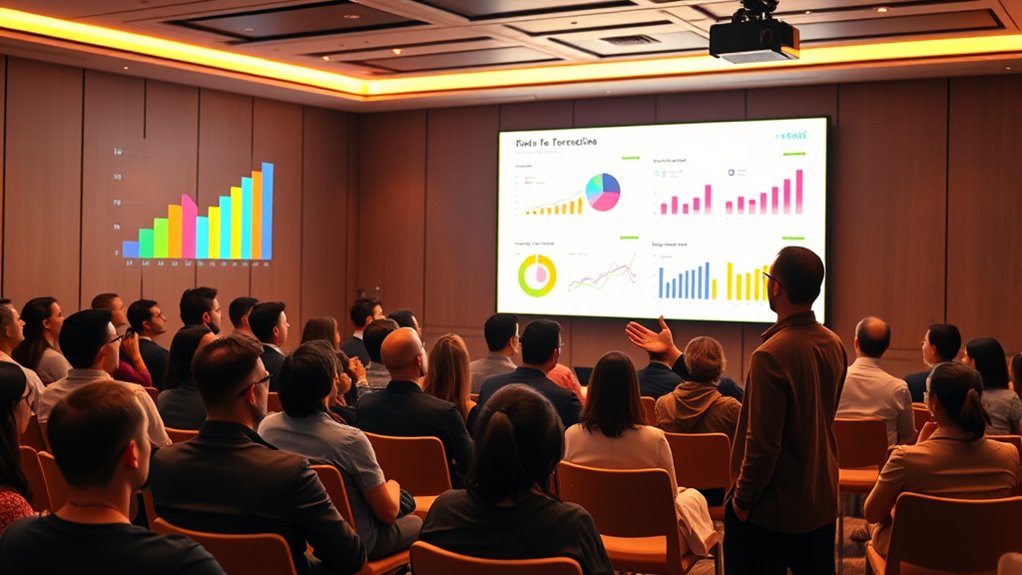Storytelling with data helps you turn complex data into clear, engaging visuals and narratives that capture attention and drive understanding. You’ll learn how to choose the right visual tools, use color strategically, and craft a logical flow that guides your audience through insights. Incorporating storytelling techniques like anecdotes and context makes your message relatable and memorable. Keep exploring, and you’ll discover how to make your data stories more persuasive, impactful, and compelling.
Key Takeaways
- Effective data storytelling combines clear narrative structure with visualizations to engage and inform audiences.
- Choosing appropriate chart types and strategic use of color enhances message clarity and impact.
- Incorporating real-world examples and emotional elements makes data more relatable and memorable.
- Simplifying visuals and avoiding clutter helps maintain focus on key insights and messages.
- A well-crafted data story guides viewers through insights, driving understanding and inspiring action.

Have you ever wondered why some data presentations captivate your attention while others fall flat? The secret often lies in how the data is visualized and the narrative techniques used to tell the story. Data visualization isn’t just about making charts look pretty; it’s about transforming raw numbers into visual cues that guide your audience’s understanding. When done well, it highlights key insights, reveals patterns, and makes complex information accessible. Effective data visualization acts as a bridge between the data and the viewer’s comprehension, allowing you to grasp the story behind the numbers quickly and intuitively. Additionally, understanding your audience’s needs and expectations enhances the effectiveness of your storytelling.
Effective data visualization reveals insights and patterns, transforming raw numbers into clear, compelling stories.
But visuals alone aren’t enough. The way you craft your story—your narrative techniques—determines whether your audience stays engaged or loses interest. Good storytelling with data combines clear, logical flow with compelling context. It starts by understanding your audience’s needs and framing the data in a way that resonates with their experiences. Use a narrative arc to introduce the problem, highlight the key insights, and lead to a meaningful conclusion. This structure keeps your audience hooked, as they follow the story rather than just passively viewing charts.
You can think of data visualization as the visual language of your story. Choose the right chart types—bar graphs, line charts, scatter plots—that best illustrate your points. Use color strategically to emphasize important trends, and avoid clutter that distracts from your core message. When your visuals align with your narrative, they reinforce your story rather than complicate it. The goal is to create a seamless flow where each visual element supports the narrative you’re telling.
Narrative techniques further enhance your storytelling by adding context and emotion to the data. Incorporate anecdotes, real-world examples, or hypothetical scenarios that make the data relevant and relatable. Use storytelling devices like tension, contrast, and suspense to guide your audience through the insights and keep them engaged. For instance, showing a surprising trend early on can pique curiosity, prompting your audience to pay closer attention to the subsequent visuals and explanations. Recognizing the importance of visual cues helps ensure your message is clear and compelling.
Ultimately, combining effective data visualization with strong narrative techniques transforms dull data into a compelling story. It’s about more than just presenting facts; it’s about guiding your audience through an experience that informs, persuades, and resonates. When you master this blend, your data stories will not only inform but also inspire action, making your presentations memorable and impactful.
Frequently Asked Questions
How Can Storytelling With Data Influence Organizational Decision-Making?
Data visualization combined with compelling narrative techniques can substantially influence your organizational decision-making. When you present data clearly and tell a story around it, you make complex insights accessible and memorable. This approach helps stakeholders understand trends, see implications, and feel motivated to act. By crafting a powerful narrative with visual data, you enable better, faster decisions that align with your organization’s goals and drive impactful results.
What Are Common Pitfalls to Avoid in Data Storytelling?
When you craft data stories, avoid common pitfalls like poor visualization clarity, which can confuse your audience, and inconsistent narratives that undermine credibility. Make certain your visuals are simple and focused, and your story flows logically. Don’t overload with data or stray from your main message. By maintaining visualization clarity and narrative consistency, you keep your audience engaged and make your insights more impactful, leading to better decision-making.
How Do Cultural Differences Affect Data Storytelling Effectiveness?
Imagine trying to tell a joke in a language you barely speak—cultural nuances and language barriers can make your data story fall flat. You might think your visuals are clear, but cultural differences shape how your audience interprets them. Ignoring these nuances risks miscommunication, like using a map that’s upside down. To connect effectively, you must adapt your storytelling to respect cultural nuances and bridge language barriers.
What Tools Best Support Storytelling With Complex Data Sets?
When you want to tell stories with complex data sets, you need powerful tools. Interactive dashboards let you explore data dynamically, making insights clearer and more engaging. Data visualization tools such as Tableau, Power BI, and QlikView help you craft compelling visuals that reveal patterns and trends. These tools enhance your storytelling by enabling you to present complex information in an accessible, interactive way that captures your audience’s attention and drives understanding.
How Can Storytelling With Data Be Adapted for Diverse Audiences?
Diverse data demands dynamic delivery. When adapting for different audiences, focus on cultural adaptation and audience engagement. You can tailor your tales by translating technical terms, respecting cultural nuances, and using relatable visuals. Keep it clear, concise, and engaging. By understanding your audience’s background and preferences, you foster familiarity and trust. This thoughtful tailoring transforms complex data into compelling stories, ensuring everyone stays engaged and informed, regardless of their diversity.
Conclusion
Just like a master storyteller weaves a compelling tale, your data becomes a vibrant tapestry when you visualize it effectively. Remember, each chart is a brushstroke, adding color and depth to your story. When you embrace clear visuals, you’re lighting a lantern in the dark, guiding your audience through the narrative. With every insight shared, you’re planting seeds of understanding—watch them grow into a forest of informed decisions and meaningful connections.










